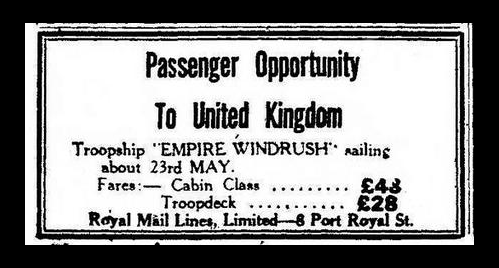In light of the ongoing Windrush ‘scandal’, where migrants are of course ‘victims‘, the mainstream media tell us that the post-war influx began as a response to fill our post-war labour shortages.
So it’s worth briefly exploring the background to both the Empire Windrush phenomenon and the history of the vessel itself.

Firstly, the Empire Windrush was initially called Monte Rosa and constructed in Hamburg, Germany.
In the 1930s the ship was used as a cruise liner and ferried German holidaymakers around under the National Socialists’ Strength through Joy leisure programme.
After being taken by the British as a prize of war and subsequently renamed, the HMT Empire Windrush was then operated by the New Zealand Shipping Company, one of many firms to benefit from the Ministry for War’s decision to give a number of these seized German ships to private operators.
The Secretary of State for War at that time was Emanuel Shinwell.
The position of Secretary of State for War has now been abolished; it’s been replaced by the politically correct Secretary of State for Defence.
In Christopher Andrew’s epic book The Defence of the Realm: The Authorized History of MI5, it was alleged that Shinwell passed secret information to the Irgun terrorist organisation, whose violent anti-British campaigns included the bombing of the King David Hotel in 1946.
Shinwell’s great-niece is the Labour MP, Luciana Berger.
The vessel carried servicemen home from the colonies mainly, but in spring 1948 the shipping company was given the go-ahead to fill-up the Empire Windrush with fee-paying commercial passengers in addition to military personnel – a decision that seemed to have no democratic legitimacy, but one which would have momentous consequences.

In the month before the ship docked in Jamaica, adverts in the local press promised affordable tickets to the UK and exciting opportunities in London.
The newly enlarged welfare state that the British government was building at this time must have seemed very appealing.
Unfortunately, the same Labour government had also enacted the Nationality Act of 1948, which allowed every citizen of a British colony the freedom to settle in the UK, with no immigration controls on them at all.
The arrival in 1948 of the Empire Windrush at the Port of Tilbury – and with it 802 people from the Caribbean – heralded the age of mass migration into the UK, and the term ‘Windrush’ has become shorthand for a generation of Afro-Caribbean migrants who came here in the following 20 years or more.
Far from being a necessary and deliberated economic decision that, coincidently, also enriched our ‘pale and stale’ land, the arrival of the Windrush Generation was ultimately a result of senior politicians and their networks failing to defend the interests of the white British.
One consequence of the politicians’ actions is that London has now overtaken New York City for the number of murders for the first time since 1800.
In 1954 the Empire Windrush caught fire and sank in the Mediterranean, with loss of life—a sad end and an apt metaphor for the legacy of mass migration onto our shores.



